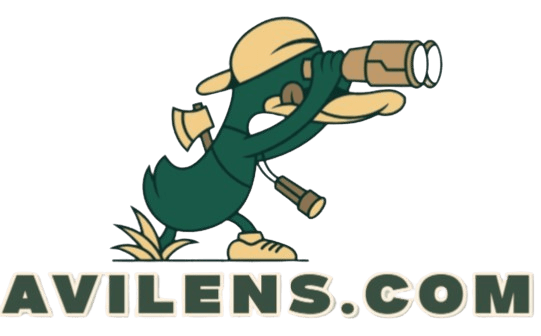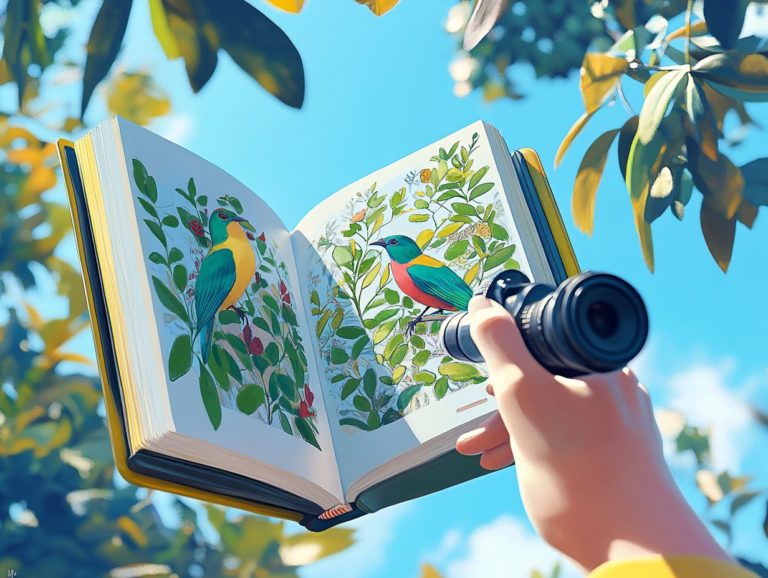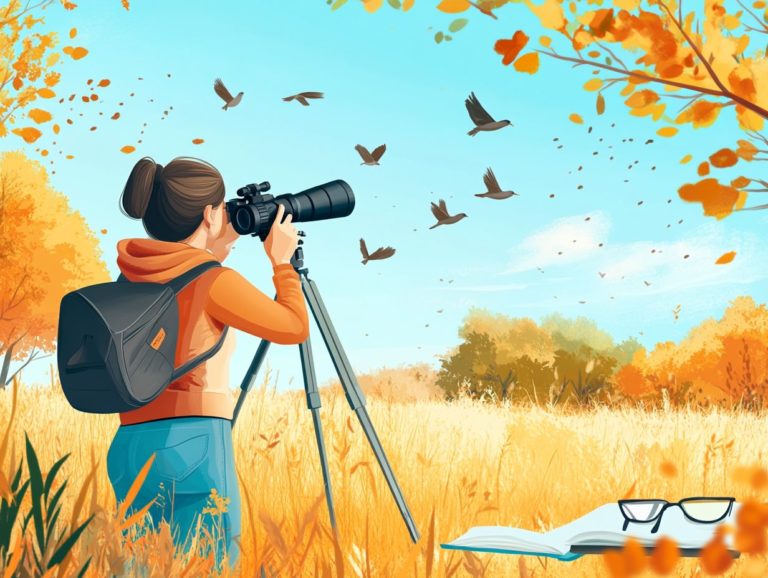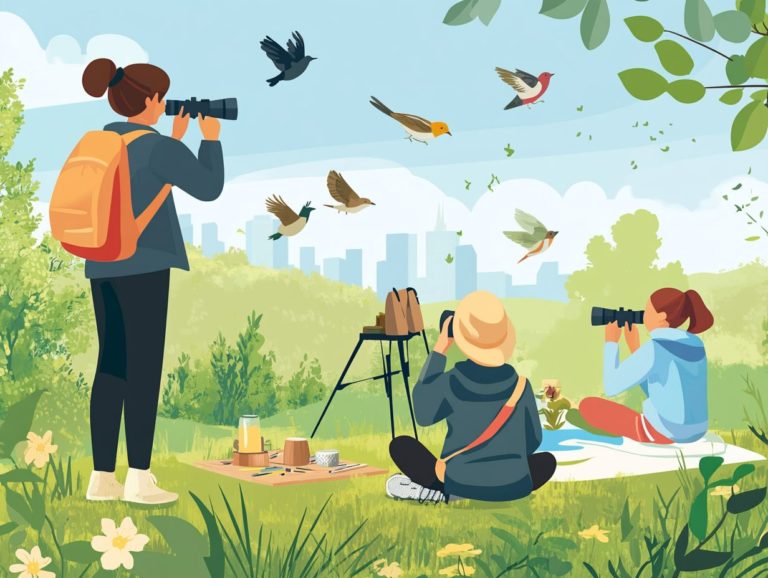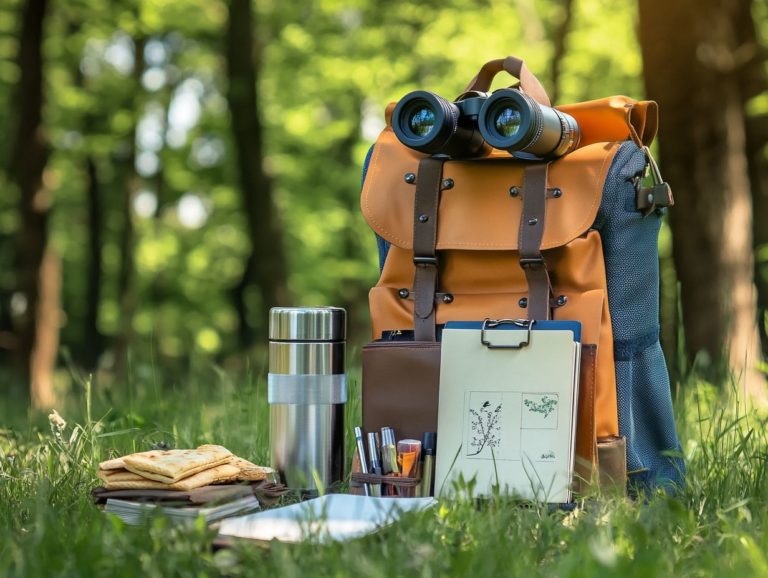What Are the Best Bird Watching Practices for Beginners?
Bird watching is an amazing adventure that connects you with nature and sharpens your observation skills! Whether you’re a curious beginner or an experienced enthusiast eager to explore the great outdoors, understanding the essential aspects of bird watching can significantly enrich your experience.
This guide provides valuable information on the basics of bird watching, including the best birding equipment such as binoculars, field guides, and apps. It covers how to find great locations for bird watching, identify common bird species, practice proper etiquette, and share your findings with the birding community.
Enjoy the journey of discovering the fascinating world of birds!
Contents
- Key Takeaways:
- Essential Equipment for Beginners
- Choosing the Right Location
- Identifying Common Birds
- Etiquette and Safety in Bird Watching
- Recording and Sharing Your Observations
- Frequently Asked Questions
- Top Bird Watching Tips for Beginners
- Why is it important to properly identify birds while bird watching?
- How can I respect birds’ natural habitat while bird watching?
- Are binoculars necessary for bird watching?
- What are the benefits of joining a local bird watching group?
- Do I need any special equipment for bird watching?
Key Takeaways:
- Invest in essential equipment like binoculars and field guides to enhance your bird watching experience as a beginner.
- Pick a location that has a variety of birds and is easy to access. This boosts your chances of spotting and identifying different species.
- Practice proper etiquette and safety measures to respect nature and protect yourself while enjoying bird watching.
What is Bird Watching?
Bird watching, or birding, is a popular and rewarding social activity that connects people with nature while positively impacting mental health and well-being. It involves observing and identifying various bird species in their natural habitats. Bird watching fosters a greater appreciation for avian life, encourages conservation efforts, and raises awareness of the biological and cultural diversity within ecosystems.
Birders, often referred to as bird watchers, utilize field guides, binoculars, and increasingly, apps like Merlin Bird ID to enrich their experiences. Community involvement in bird watching is evident through clubs such as the Audubon Society and events organized by individuals like Sharon Stiteler, known as Birdchick.
As individuals embark on this fulfilling journey, they experience the beauty of birds while also forming friendships and shared experiences that extend beyond mere identification. Join the movement for bird conservation! Together, we can protect these essential species and their homes.
The mental health benefits of engaging with nature through birding are well documented, offering stress relief and promoting mindfulness. This makes bird watching a holistic pursuit that benefits both individuals and the environment.
Essential Equipment for Beginners
The right equipment is crucial for beginner birders, as it can significantly enhance their bird-watching experience and increase their chances of spotting various species.
Binoculars are essential for bringing distant birds into clearer view, while a field guide featuring images and descriptions of regional birds aids in identification.
Accessibility in birding is vital. It ensures everyone, regardless of mobility challenges, can enjoy the joy of watching birds.
Binoculars, Field Guides, and Other Must-Haves
Essential tools for birdwatching include binoculars, a field guide, and various accessories that enhance the overall experience of observing birds. Binoculars are crucial for obtaining close-up views of birds in their natural habitats, while resources like the National Geographic Field Guide provide valuable information for accurately identifying different species, including the spruce grouse.
Other essential items contribute to making birdwatching more accessible and inclusive for everyone.
Choosing Binoculars for Birdwatching
When selecting binoculars, consider the most important factors: magnification, objective lens diameter, and field of view. Magnification shows how much closer a bird appears. A higher number means a closer view. The objective lens diameter affects visibility in low light; a larger diameter generally offers better brightness. The field of view indicates the distance visible through the binoculars, typically specified in feet at 1,000 yards.
Generally, binoculars with 8x or 10x magnification and an objective lens diameter of 42 to 50 mm provide a good balance of clarity and brightness without being too heavy to carry comfortably.
Types of Binoculars
Binoculars can be categorized into compact and standard types, with a special mention of specialty binoculars. Compact binoculars are lightweight and easy to store. However, they have smaller lenses that let in less light, which can reduce visibility in low-light conditions.
Standard binoculars offer a wider field of view and greater brightness, but they are often heavier. Specialty binoculars, like waterproof models, cater to specific environments, such as birdwatching near water.
Your Ultimate Guide to Birdwatching Success!
A quality field guide is critical for birdwatchers. It offers diagrams, photographs, and written descriptions to help identify different species, including vital information on birds like the spruce grouse. A well-illustrated and organized guide is essential for recognizing subtle differences between similar birds.
One of the most popular resources is the National Geographic Field Guide to Birds of North America. This guide details over 1,300 species found throughout North America, including foreign species that occasionally migrate to the region.
Keeping a Bird Field Journal
For those interested in documenting their observations, a field journal can enhance the birdwatching experience. While not mandatory, a journal allows birdwatchers to track patterns and make notes about their findings.
Bird Photography Setup
A camera or drone can be beneficial for capturing images of birds in their natural settings. For many enthusiasts, photography adds an exciting layer to birdwatching. High-resolution cameras or drones enable birdwatchers to document their observations and share their experiences, contributing to the birding community.
Utilizing Bird Calls
Bird calls—recordings of various avian sounds—can attract birds or help identify species by their calls. These recordings are useful tools for birdwatchers looking to enhance their experience.
Accessibility in Birdwatching
Birding equipment designed with accessibility in mind ensures that individuals with physical limitations can enjoy the activity fully. Essential accessible birdwatching gear includes:
- Birding Chairs: Comfortable seating options for those with limited mobility.
- Birding Scopes: Telescopes designed for wheelchair-accessible areas, allowing for comfortable viewing.
- Birding Platforms: Designated areas with railings for safe observation from wheelchairs.
Social Aspects of Birdwatching
Getting help from others is essential for individuals with mobility issues during birdwatching. This is particularly true in communities like the Feminist Bird Club and In Color Birding Club. Having a guide can enhance the experience by ensuring a good view of the birds. Joining birding groups can also help those with mobility challenges find accessible sites for observation.
Choosing the Right Location
Selecting the right location for birdwatching is vital for a successful outing. Different habitats attract various bird species.
Popular birdwatching spots, such as Central Park and Denali National Park in Alaska, offer unique opportunities to observe a diverse range of birds, especially in the early morning when they are most active.
Joining local birding clubs can greatly enhance your birdwatching experience. These clubs provide valuable information on the best locations and times to observe the species you are most interested in.
Factors to Consider for a Successful Birdwatching Experience
When planning birdwatching outings, consider several important factors, including location, time of day, weather, and accessibility. These elements ensure a successful experience.
Selecting the right location is arguably the most crucial factor, as different habitats support various types of birds. Wetlands, forests, grasslands, and urban areas each host unique assemblages of avian life.
Timing is also significant. Many birds are most active during dawn and dusk, and birdwatchers are often treated to a chorus of chirps as the birds awaken and settle in for the night.
Weather plays a crucial role as well. Many birdwatchers report that overcast skies can enhance visibility, while rain may drive birds into cover, resulting in decreased activity.
Accessibility is another important consideration. It ensures that everyone can enjoy birdwatching, regardless of their physical abilities. Novice birders are encouraged to research local conditions and identify potential barriers to optimize their experience.
Planning and experiencing birdwatching is thrilling, as every outing holds the promise of discovering something new!
Identifying Common Birds
Identifying common birds is one of the most enjoyable aspects of birdwatching, especially for beginner birders who are still learning about various species. The spruce grouse is one such species that can be observed.
Birders can utilize tools like eBird to log their sightings, which helps enhance their identification skills and fosters participation in birding clubs. An increased awareness of the diversity in birdlife enriches the overall birdwatching experience.
It is essential for birdwatchers at all levels to develop familiarity with the species in their surroundings.
Tips for Recognizing and Differentiating Bird Species
Recognizing and differentiating between various bird species requires careful observation and a solid understanding of visual features, behaviors, and sounds. Birdwatchers should learn to identify birds and use a field guide, which is a book that helps you identify different bird species.
Familiarity with common characteristics such as feather color, size, and behavior can help distinguish different species. Listening for species-specific calls can enhance identification skills.
To develop overall identification abilities, birdwatchers can start by familiarizing themselves with the species found in their area, utilizing a field guide that includes illustrations and descriptions of local birds. Other helpful strategies include:
- Observing birds in their natural habitats and using binoculars to focus on specific individuals.
- Utilizing smartphone apps to record calls and songs, which can improve auditory recognition and serve as a reference for comparisons.
- Practicing patience, as honing these skills takes time.
- Keeping a sighting journal, which not only tracks progress but also encourages further learning and enhances the enjoyment of the avian world.
Etiquette and Safety in Bird Watching
Etiquette and safety in birdwatching are essential for respecting nature and ensuring a positive experience for fellow birders. Guidelines that promote wildlife well-being, such as maintaining a safe distance and minimizing noise, protect bird habitats and contribute to a sustainable environment for future birdwatchers.
Additionally, following safety protocols is crucial to ensure that birdwatchers can enjoy their adventures without encountering harm.
Respecting Nature and Protecting Yourself
Respecting nature and protecting oneself while birdwatching involves adhering to wildlife observation principles and practicing personal safety measures. Birders should prioritize nature preservation by engaging in responsible conduct that minimizes habitat intrusion. It’s also important to be mindful of their own safety in various environments.
This approach ensures the health of bird populations and preserves the environment for future generations to enjoy. Being aware of potential dangers, such as rough terrain, unpredictable weather, or encounters with wildlife, is essential for a safe birding experience.
Staying conscious of one’s surroundings can help prevent accidents and foster a deeper connection with nature. Utilizing the right gear, staying adequately hydrated, and informing others of your travel plans can enhance safety, allowing birders to immerse themselves in the beauty of natural environments without jeopardizing their health or the integrity of wildlife habitats.
Recording and Sharing Your Observations
Sharing your birdwatching adventures not only connects you with nature but also builds a vibrant community of fellow bird lovers! Recording and sharing observations are essential aspects of birdwatching that foster community within the birding world and support conservation efforts for birds.
Platforms like eBird enable birders to document their sightings, share valuable data with conservation organizations, and connect with fellow birders, all while enhancing their own skills and knowledge.
Tools and Platforms for Documenting and Contributing to the Bird Watching Community
The following tools and platforms help record observations and bring people together among bird watchers. Birding apps make it easy to keep track of what birds you see and provide insights into local bird populations.
Organizations such as Birdability promote accessibility and inclusivity within the birding community. Apps like BirdTrack and iNaturalist encourage bird watchers to document their observations and share them with a broader network. This sharing fosters collaboration among users.
These platforms let bird watchers quickly share their findings and help protect our feathered friends! Additionally, social media groups and forums offer great places to discuss and learn more about bird watching. With these technologies, bird watchers can connect, exchange tips, and engage in local projects that make the hobby more accessible to everyone, regardless of skill level or physical ability.
Frequently Asked Questions
Top Bird Watching Tips for Beginners
- Properly identify birds.
- Respect their natural habitat.
- Use binoculars.
- Join a local bird watching group.
Why is it important to properly identify birds while bird watching?
Properly identifying birds allows for a more fulfilling bird watching experience and contributes to their conservation efforts.
How can I respect birds’ natural habitat while bird watching?
Respecting birds’ natural habitat means:
- Not disturbing their nests.
- Avoiding loud noises.
- Leaving no trace of your visit.
Are binoculars necessary for bird watching?
While not necessary, binoculars greatly enhance the bird watching experience by allowing you to see birds up close without disturbing them.
What are the benefits of joining a local bird watching group?
Joining a local bird watching group provides valuable knowledge, resources, and a community of fellow bird watchers to share the experience with.
Do I need any special equipment for bird watching?
No special equipment is necessary, but wearing appropriate clothing and bringing a field guide can be helpful.
Ready to start your bird-watching journey? Join a local group today!
